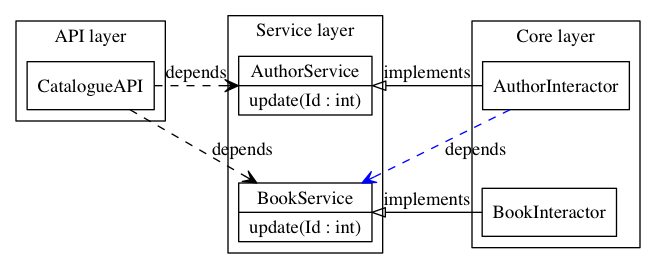The Presentation Layer¶
The introduction of the API layer at this point may seem a bit heavy-handed. Why not map the interactor methods directly to routes? I mean, you could spin up a web server that handles Sinatra-like requests and then points them to the right interactor and returns a serialized version of whatever the interactor spewed out.
Indeed, if you have one interactor or a couple that don’t ever do business together, this seems like the right approach. Once you get too many, it gets useful to wrap them underneath a single unit.
Suppose you have an API endpoint of a book catalogue, and you want to implement functionality that that modifies a particular author and at the same time transfers these modifications to the publications. You receive the new author name as input, and then you must update the author itself and their book catalogue in one go.
Sure, sounds easy, just create a ModifyCatalogue functionality into
the Author interactor. The interactor, in this case, would modify
the author’s name, then loop over its Books and modify them
individually, finally sending the updates to a database. This system
works as long as the Book entities are under the sole ownership of
an Author–that is, there is no way of adding, creating, deleting,
or modifying a book from outside.
As soon as you introduce a Book interactor into the mix, things
start to get hairy. The Author service, retaining its book
modification logic, now overlaps with the Book service. The imminent
solution to this is to lift this logic from the Author interactor to
the Book interactor, making the layout look like this.

Could the blue arrow be removed, and contained inside the arrows from the API layer pointing towards the Service layer?
The blue dashed arrow can be lifted into the API layer with little extra work. It’s a good idea to push such arrows as far “up” as possible, because this helps keep one thing in check: not violating the single responsibility principle, which roughly means that your interactor should do one thing and one thing only. So the Author interactor should only care about author logic, and the Book interactor should care only about book issues.
In the above example this process would not be violated if there was no Book service, such that book-related logic was underneath the Author interactor. But, as soon as you start sharing responsibilities, and they start to overlap, you will run into problems.
Hence, the API layer is there to provide additional logic that ties two interactors together. You could think of it as a meta-interactor, something that operates on interactors only, but contains no low-level business logic.
What is more, the API layer usually has some knowledge of the application domain: while interactors deal with dumb objects (DTOs), the API may be dealing with HTTP request objects. Thus, the API is closer to the actual implementation.
Consequently, the Core layer is the non-duplicated, non-overlapping part of the application: you may have multiple APIs for the same set of interactors, and multiple hosts for each API, but at the fundamental level, there’s only one canonical implementation of the core.
To conclude, the key differences between an API and an interactor are the following:
- An API is domain-specific and knows about the target implementation. The API knows it is talking to a web server. It just doesn’t know which kind of web server it is talking to, acting as a bridge between interactors and the delivery mechanism.
- The API layer may tie a multitude of interactors together, without making them dependent on each other, enforcing loose coupling.
- APIs can be seen as “meta-interactors”, operating on interactors the same way interactors operate on entities.